
Xantusia is one of three genera of night lizards. Species of Xantusia are small to medium-sized, viviparous (live-bearing) lizards found in the U.S. Southwest and in northern Mexico.

The island night lizard is a species of night lizard native to three of the Channel Islands of California: San Nicolas Island, Santa Barbara Island, and San Clemente Island. A small number of island night lizards also live on Sutil Island, near Santa Barbara Island.

Night lizards are a group of small scincomorph lizards, averaging from less than 4 cm (1.6 in) to over 12 cm (4.7 in) snout–vent length. Most species are viviparous (live-bearing), with the exception of those in the genus Cricosaura. The family has only three living genera, with approximately 34 living species. The genera are divided by geographic range: Xantusia in southwestern North America and Baja California, Cricosaura in Cuba, and Lepidophyma, the most populous night lizard genus, in Central America. Three fossil genera are also known: Catactegenys, Palepidophyma, Palaeoxantusia.
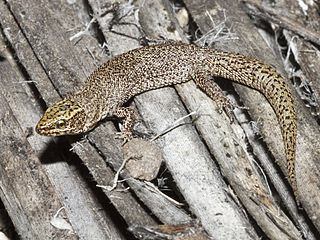
The desert night lizard is a night lizard native to the Southern California Eastern Sierra and the San Gabriel Mountains into Baja California, southern Nevada, southwestern Utah and extreme western areas of Arizona.

Oxybelis aeneus, commonly known as the Mexican vine snake or brown vine snake, is a species of colubrid snake, which is endemic to the Americas.
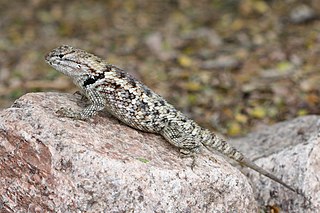
Sceloporus magister, also known as the desert spiny lizard, is a lizard species of the family Phrynosomatidae, native to the Chihuahuan Desert and Sonoran Desert of North America.
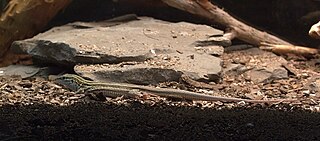
The desert grassland whiptail lizard is an all-female species of reptiles in North America. It was formerly placed in the genus Cnemidophorus. A common predator of the whiptail lizard is the leopard lizard, that prey on A. uniparens by using ambush and stalk haunting tactics. These reptiles reproduce by parthenogenesis. In this process, eggs undergo a chromosome doubling after meiosis, developing into lizards without being fertilized. However, ovulation is enhanced by female-female courtship and "mating" (pseudo-copulation) rituals that resemble the behavior of closely related species that reproduce sexually.
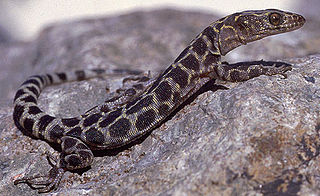
The granite night lizard is a species of xantusiid lizard endemic to North America.

The western long-tailed brush lizard is a species of lizard in the family Phrynosomatidae. The species is native to the southwestern United States and adjacent northern Mexico.

Crotalus willardi is a venomous pit viper species found in the southwestern United States and Mexico. This snake is found mainly in the "sky island" region. The IUCN reports this snake's conservation status as being of Least Concern. It is the official state reptile of Arizona.

The western diamondback rattlesnake or Texas diamond-back is a rattlesnake species and member of the viper family, found in the southwestern United States and Mexico. Like all other rattlesnakes and all other vipers, it is venomous. It is likely responsible for the majority of snakebite fatalities in northern Mexico and the greatest number of snakebites in the U.S. No subspecies are currently recognized.
The sandstone night lizard is a species of night lizard. Prior to 2005, it was considered a subspecies of the granite night lizard, Xantusia henshawi. The physical difference is that the sandstone night lizard has lighter coloration.
The Arizona night lizard is a species of small smooth-skinned gray-brown lizards with dark spots that sometimes form partial lines down the back. The lizard has a slightly flattened head. The scales of the underside and tail are larger than those of the upper side. The lizard grows to a length of 6 to 10 cm.

The tiger rattlesnake is a highly venomous pit viper species found in the southwestern United States and northwestern Mexico. No subspecies are currently recognized. The specific name tigris,, refers to the many narrow dorsal crossbands, which create a pattern of vertical stripes when viewed from the side.
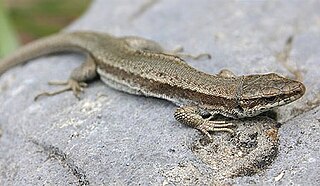
The Pyrenean rock lizard is a species of lizard in the family Lacertidae. The species is endemic to the Pyrenees, where it occurs at high altitudes and is only active in summer.
The bolsón night lizard is a species of night lizard in the family Xantusiidae. The species, which was originally described by Robert G. Webb in 1970, is endemic to the state of Durango in Mexico. Not much is known about the lizard at present, as it appears to be simultaneously rare and rather secretive in nature.
Xantusia jaycolei is a species of lizard in the family Xantusiidae. The species is native to Mexico.
Xantusia sanchezi, Sanchez's night lizard, is a species of lizard in the family Xantusiidae. It is a small lizard found in Mexico.













